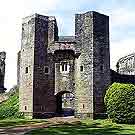Berry Pomeroy

Base layers
Data layers

Other Images
Venue Type & Location
Site Name: Berry Pomeroy
Location: near Totnes
County: Devon
Location Type: Town - near town at determined location
Performance Spaces
Overview
Located high on a rocky promontory overlooking Gatcombe Brook in wooded hills 2 miles NE of Totnes.
Only the imposing gatehouse, one tower and part of the curtain wall remain from the medieval slate castle built by the Pomeroy family, but the walls and some of the features of the fashionable Elizabethan limestone house of the Seymours remain within the original defensive walls.
Performance History
A probable performance venue. Entertainers patronized by a member of the Pomery family in the late 15th c. and by Sir Edward Seymour in the later 16th c. performed elsewhere in Devon.
Current Status
The property is still owned by the Seymour family but the ruins are maintained and managed by English Heritage. Open to the public at specified times.
History of the Venue
1066 Manor granted with other Devon estates to Ralf de Pomeroy.
by 1293 The Pomeroy family resided in a manor house in the village of Berry Pomeroy next to the church.
1496 First recorded mention of the castle.
early 16th c. Remodelling by Sir Edward Pomeroy.
1547 Sir Thomas Pomeroy sold the castle to Edward Seymour, 5th Duke of Somerset.
1553 Castle granted to Sir Edward Seymour, son of the 5th Duke of Somerset by his first wife.
1560 Sir Edward began reconstruction of the domestic buildings with a fashionable renaissance house of 3 ranges around an inner courtyard inside the older defensive walls.
ca. 1600 Sir Edward's son Sir Edward, 1st Bart., built a new wing along the NW side with formal state rooms overlooking Gatcombe Valley. Plans to extend the landscaping and build another range of rooms on the W side later abandoned.
1688--1701 Site abandoned when the family relocated their principal residence to Maiden Bradley, Wiltshire.
1701 Castle described as ruinous and soon after stripped of building materials.
Record Source
REED Devon 34, 162
Patrons who owned this venue
| Name | Dates | Titles |
|---|---|---|
| Pomery, Henry | 1413-1487 | |
| Pomery, Richard | 1441-1496 | Knight |
| Seymour, Edward | 1529-1593 | Lord , Knight |
Bibliographic Sources
-
Brown, Stewart. Berry Pomeroy Castle Devon. London: English Heritage, 1997.
-
Buck, Samuel, and Nathaniel Buck. [A Collection of Engravings of the Castles, Abbeys, and Towns in England and Wales]. 5 vols. London: The authors, 1726–52.
-
Cherry, Bridget, and Nikolaus Pevsner. Devon. The Buildings of England. London: Penguin Books, 1989.
-
Clare, T. Archaeological Sites of Devon and Cornwall. Ashbourne, Derbyshire: Moorland, 1982.
-
Gray, Todd. The Garden History of Devon: An Illustrated Guide to Sources. Exeter: U of Exeter P, 1995.
-
Hoskins, W.G. Devon. A New Survey of England. Newton Abbot: David & Charles, 1973.
-
Mackenzie, James D. The Castles of England: Their Story and Structure. 2 vols. New York: The Macmillan Co., 1896.
-
Oman, Charles W.C. Castles. London: The Great Western Railway, 1926.
-
Pettifer, Adrian. English Castles: A Guide by Counties. Woodbridge: The Boydell P, 1995.
-
Polwhele, Richard. The History of Devonshire. 1st ed. [1793–1806] printed by Trewman and Son for: Cadell, Johnson and Dilly (vol 1); Cadell, Dilly and Murray (vol 2); Cadell and Davies (vol 3); all in London. 3 vols. Dorking: Kohler & Coombes, 1977.
-
Powley, Edward B. 'Berry Pomeroy Castle, Devon.' Country Life 90 (1941): 1122–5.
-
Salter, Mike. The Castles of Devon and Cornwall. Malvern, Worc: Folly Publications, 1999.
-
Saunders, Andrew. Devon and Cornwall. London: HMSO, 1991.
-
Slade, H.G. 'Berry Pomeroy Castle.' Archaeological Journal Supplement 147 (1990): 66–70.
-
Somerset Fry, Plantagenet. Castles of the British Isles. New York: Dorset P, 1990.
-
Whitley, H. Michael. 'Berry Pomeroy Castle.' Transactions of the Devonshire Archaeological Association 27 (1895): 285–93.
-
Worthy, Charles. 'Berry Castle and its Ancient Lords.' Report and Transactions of the Devonshire Association for the Advancement of Science, Literature and Art 15 (1883): 426–40.




